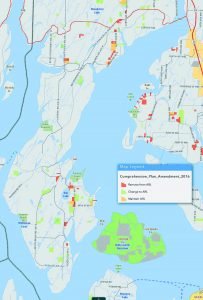 Proposed ARL redesignation on the Key Peninsula. Courtesy Pierce County
Proposed ARL redesignation on the Key Peninsula. Courtesy Pierce County
The Key Peninsula Land Use Advisory Commission (LUAC) met Dec. 21 to hear recommendations from Pierce County Land Services (PALS) regarding redesignation of Agricultural Resource Lands (ARL) on the KP. Because of concerns raised by LUAC members and some of the 25 attendees, LUAC recommended that the suggested changes for the Key Peninsula not be adopted.
Their input was sent to the county planning commission, which held a hearing Jan. 10. The commission, after reviewing feedback from the local advisory commissions and hearing testimony, will send its recommendation to the Pierce County Council for a committee review and final vote.
The county council hired a consulting team in 2016 to analyze Pierce County’s agriculture sector and evaluate the effectiveness of the zoning regulations for protecting agricultural lands in a report titled “A Fresh Look at Pierce County Agriculture.” Although the study stated that the current regulations comply with state requirements, changes were recommended to reflect the actual farming practices in the county and to better protect farmland from being lost to urban development.
The report recommended dividing Pierce County into four agricultural production districts to reflect the agricultural variations in the county—from intensive row crops in the fertile Puyallup Valley to the small fruit and vegetable farms and relatively poor soil in places like the Key Peninsula. The districts are Puyallup/Orting Valley, Central and Southern County, Bonney Lake, Buckley Plateau and the Peninsula District, which includes Gig Harbor and Anderson Island.
PALS Senior Planner Jeff Mann, who was not at the LUAC meeting, described the process in an interview with KP News. He explained that the purpose of ARL zoning is to identify parcels with the size and soil characteristics that would best accommodate agriculture while protecting agricultural land from development. ARL zoning reduces development potential, especially on smaller parcels, but it does not require that the land be farmed. The main changes in ARL criteria were to increase parcel size (from 5 to 10 acres on the Key Peninsula), to eliminate a crop production requirement and to make some adjustments in soil quality requirements.
PALS staff also recommended that landowners who wanted to have their parcel designated ARL could do so, with no parcel size or other requirement.
In the Peninsula District, the changes recommended were as follows: 1,411 acres and 62 ARL parcels to be added; 738 acres and 96 ARL parcels to be removed. Because some designations were unchanged, the total ARL designated land would be 1,777 acres and 76 parcels.
Janice and Warwick Bryant of Kaukiki Farms attended the LUAC meeting, and Janice had been interviewed previously as a stakeholder for the ARL study. She noted some inconsistencies in how new lands were designated. “One of our pastures with the poorest soil was designated as ARL while other parcels on the peninsula were not. It appears that the soil quality data used was from the 1950s, and that the soil on well-farmed parcels has likely improved over time. Some say that soil makes a farm; in reality a good farmer makes a difference in the soil,” she said.
Warwick commented that he is worried that restrictions from an ARL designation could affect how their sons might be able to develop their land in the future.
Others at the meeting expressed concern about land that has been in their families for decades and never been anything but forest, but will be rezoned as ARL if the country approves the recommendations. They worried how their land might be taxed as well as the limits placed on what they might be able to do with their property.
Mann explained that the state’s legally mandated soil-quality requirements are based on a database from the National Soil Conservation Service of the U.S. Department of Agriculture. The last survey of Pierce County was in 1979. He noted that when criteria-based standards are used, the inclusion and exclusion of parcels could appear to be arbitrary. He has been checking the accuracy of designations over the past months and has found no errors.
Mann also explained that the zoning of land as ARL does not mean that land must be used for farming; it simply means that the land meets the criteria.
Sue Testo, of the Pierce County Assessor-Treasurer’s Office, stated that how land is zoned does not impact participation in the county’s current use tax programs that allow for land to be taxed at a lower assessed value, if the parcel meets the requirements. There are three tax programs: agriculture and farming, open space and designated forestland. The current use tax programs have nothing to do with zoning.
County Councilman Derek Young supports the changes, but noted that the recommendations presented at the December LUAC meeting included some errors. Some parks and recreation land was included in the re-zoning, as were some parcels that are participating in the current designated-forestland tax program. “We do not want to convert land being used as forestland into ARL,” he said.
Young also pointed out that the main objective is to identify and preserve prime agricultural land. “Some of the richest farmland in the Puyallup River Valley is no longer farmland; it is covered by warehouses. We need to be sure that this sort of thing doesn’t happen again. With an ARL designation, an owner can still build a home, just as with an R10 designation. You couldn’t build a church or community center.”
For more information on the county’s recommendations, go to www.freshlookatpierceag.org.
UNDERWRITTEN BY THE FUND FOR NONPROFIT NEWS (NEWSMATCH) AT THE MIAMI FOUNDATION, THE ANGEL GUILD, ADVERTISERS, DONORS AND PEOPLE WHO SUPPORT INDEPENDENT, NONPROFIT LOCAL NEWS